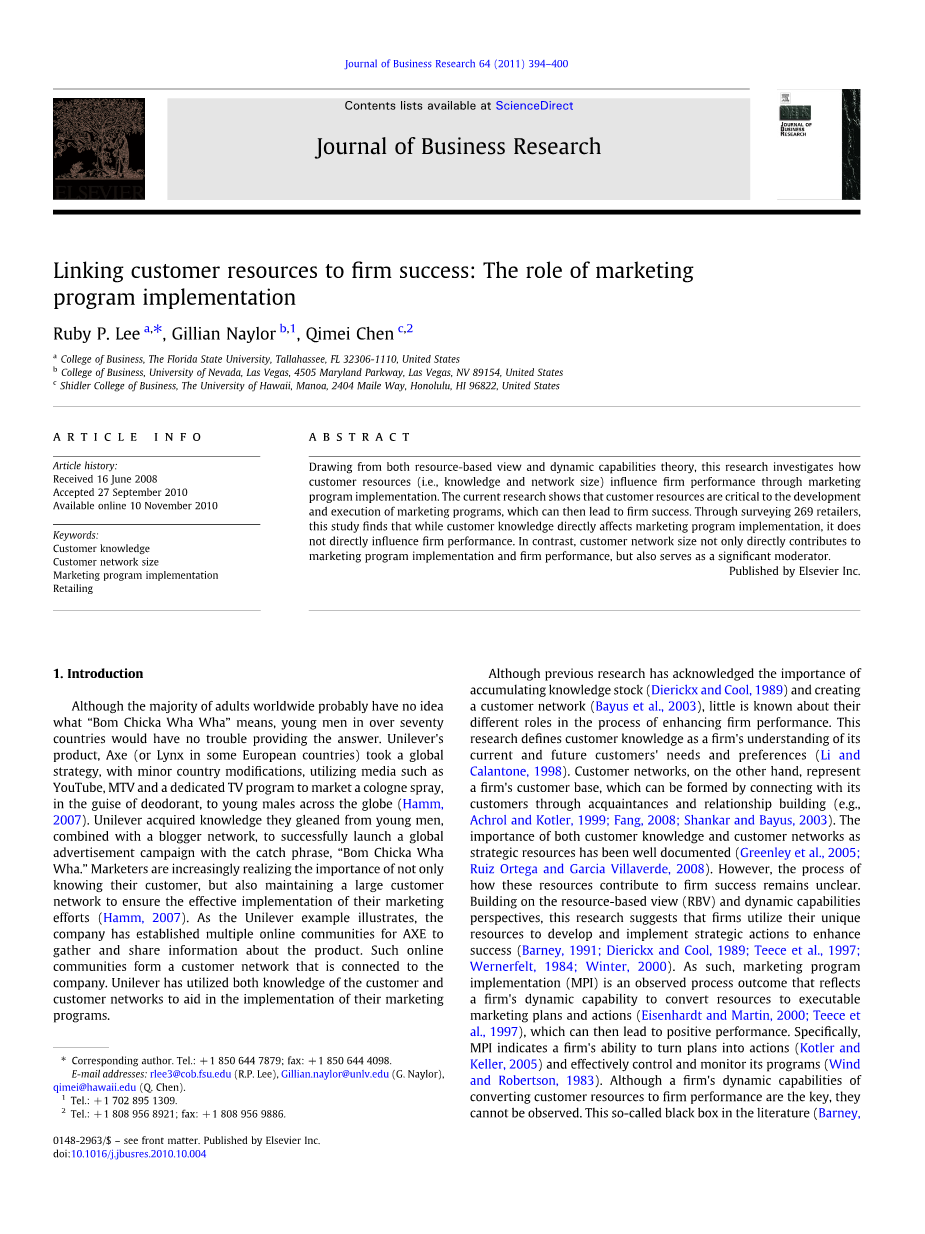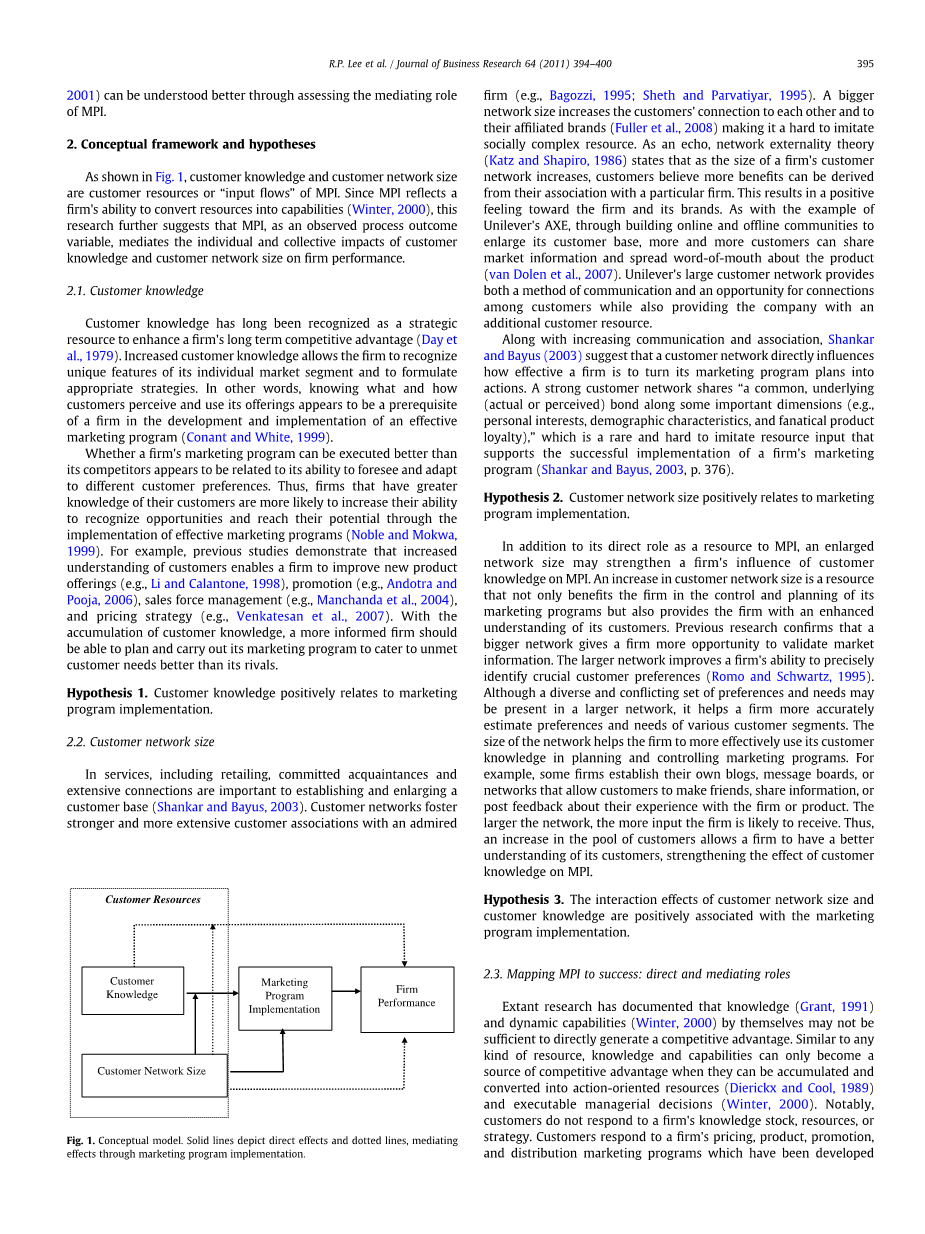

英语原文共 7 页,剩余内容已隐藏,支付完成后下载完整资料
Journal of Business Research(Elsevier)
Linking customer resources to firm success: The role of marketing program implementation
Ruby P. Lee a,⁎, Gillian Naylor b,1, Qimei Chen c,2
a College of Business, The Florida State University, Tallahassee, FL 32306-1110, United States
b College of Business, University of Nevada, Las Vegas, 4505 Maryland Parkway, Las Vegas, NV 89154, United States
c Shidler College of Business, The University of Hawaii, Manoa, 2404 Maile Way, Honolulu, HI 96822, United States
Abstract: Drawing from both resource-based view and dynamic capabilities theory, this research investigates how customer resources (i.e., knowledge and network size) influence firm performance through marketing program implementation. The current research shows that customer resources are critical to the development and execution of marketing programs, which can then lead to firm success. Through surveying 269 retailers, this study finds that while customer knowledge directly affects marketing program implementation, it does not directly influence firm performance. In contrast, customer network size not only directly contributes to marketing program implementation and firm performance, but also serves as a significant moderator.
1. Introduction
Although the majority of adults worldwide probably have no idea what “Bom Chicka Wha Wha” means, young men in over seventy countries would have no trouble providing the answer. Unilever#39;s product, Axe (or Lynx in some European countries) took a global strategy, with minor country modifications, utilizing media such as YouTube, MTV and a dedicated TV program to market a cologne spray, in the guise of deodorant, to young males across the globe (Hamm,2007). Unilever acquired knowledge they gleaned from young men, combined with a blogger network, to successfully launch a global advertisement campaign with the catch phrase, “Bom Chicka Wha Wha.” Marketers are increasingly realizing the importance of not only knowing their customer, but also maintaining a large customer network to ensure the effective implementation of their marketing efforts (Hamm, 2007). As the Unilever example illustrates, the company has established multiple online communities for AXE to gather and share information about the product. Such online communities form a customer network that is connected to the company. Unilever has utilized both knowledge of the customer and customer networks to aid in the implementation of their marketing programs.
Although previous research has acknowledged the importance of accumulating knowledge stock (Dierickx and Cool, 1989) and creating a customer network (Bayus et al., 2003), little is known about their different roles in the process of enhancing firm performance. This research defines customer knowledge as a firm#39;s understanding of its current and future customers#39; needs and preferences (Li and Calantone, 1998). Customer networks, on the other hand, represent a firm#39;s customer base, which can be formed by connecting with its customers through acquaintances and relationship building (e.g., Achrol and Kotler, 1999; Fang, 2008; Shankar and Bayus, 2003). The importance of both customer knowledge and customer networks as
strategic resources has been well documented (Greenley et al., 2005; Ruiz Ortega and Garcia Villaverde, 2008). However, the process of how these resources contribute to firm success remains unclear. Building on the resource-based view (RBV) and dynamic capabilities perspectives, this research suggests that firms utilize their unique
resources to develop and implement strategic actions to enhance success (Barney, 1991; Dierickx and Cool, 1989; Teece et al., 1997; Wernerfelt, 1984; Winter, 2000). As such, marketing program implementation (MPI) is an observed process outcome that reflects firm#39;s dynamic capability to convert resources to executable marketing plans and actions (Eisenhardt and Martin, 2000; Teece et al., 1997), which can then lead to positive performance. Specifically, MPI indicates a firm#39;s ability to turn plans into actions (Kotler and Keller, 2005) and effectively control and monitor its programs (Wind and Robertson, 1983). Although a firm#39;s dynamic capabilities of converting customer resources to firm performance are the key, they cannot be observed. This so-called black box in the literature (Barney, 2001) can be understood better through assessing the mediating roleof MPI.
2. Conceptual framework and hypotheses
As shown in Fig. 1, customer knowledge and customer network size are customer resources or “input flows” of MPI. Since MPI reflects a firm#39;s ability to convert resources into capabilities (Winter, 2000), this research further suggests that MPI, as an observed process outcome variable, mediates the individual and collective impacts of customer knowledge and customer network size on firm performance.
2.1. Customer knowledge
Customer knowledge has long been recognized as a strategic resource to enhance a firm#39;s long term competitive advantage (Day et al., 1979). Increased customer knowledge allows the firm to recognize unique features of its individual market segment and to formulate appropriate strategies. In other words, knowing what and how customers perceive and use its offerings appears to be a prerequisite of a firm in the development and implementation of an effective marketing program (Conant and White, 1999). Whether a firm#39;s marketing program can be executed better than its competitors appears to be related to its ability to foresee and adapt to different customer preferences. Thus, firms that have greater knowledge of their customers are more likely to increase their ability to recognize opportunities and reach their potential through the implementation of effective marketing programs (Noble and Mokwa, 1999). For ex
剩余内容已隐藏,支付完成后下载完整资料
资料编号:[468141],资料为PDF文档或Word文档,PDF文档可免费转换为Word


